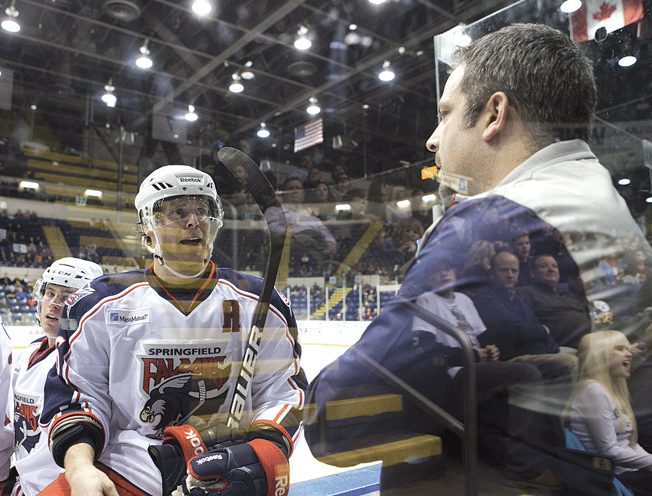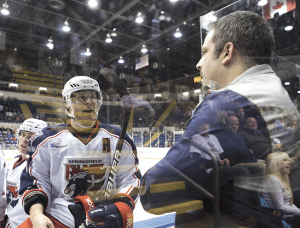
Net Results
Head Trainer Tom Bourdon Keeps the Falcons Flying

Tom Bourdon (right) says athletic trainers hope for the best but prepare for the worst, knowing they have to be ready for any situation that may arise during a game or practice.
“We always hope for the best and prepare for the worst. That’s the way we approach it. You just never know when there’s going to be an emergency, and Sunday was a prime example of that,” he said a few days after Wade MacLeod collapsed on the ice in a Feb. 17 matchup against visiting Adirondack.
MacLeod had just been checked into the boards late in the second period and was headed to the bench when he suffering an apparent seizure — a situation so frightening that both teams agreed to postpone the remainder of the game. MacLeod’s family later reported that a CT scan discovered a benign mass in his brain.
“We got the best results we could have possibly hoped for in that he was removed from the ice and got the medical attention he needed as quickly as possible,” Bourdon said, emphasizing at the same time that MacLeod’s long-term outlook is still uncertain.
“You just never know — since I’ve been here, we’ve never had an on-ice emergency. That’s not to say this weekend we won’t have another one. You just don’t know, and you always have to be ready. We go through a lot of training, and you hope.”
Most days for Bourdon aren’t nearly as harrowing. As head athletic trainer, he puts in long hours performing a variety of duties for Springfield’s American Hockey League franchise, all aimed at maintaining his players’ health.
“I’m fully in charge of the players’ well-being, from treating their injuries to diagnosing illness — just making sure the players are ready to go on the ice,” he explained. “That includes evaluating them and deciding when there is an injury, deciding what treatments we need to seek, and then seeking those treatments.”
This month, BusinessWest sits down with Bourdon — whose decade-plus of experience with professional hockey teams includes three seasons with the Falcons — to talk about the day-to-day life of a head trainer, and how it melds his passions for sports and medicine in many satisfying ways.
Head Games
Bourdon, who had played sports his whole life, was first intrigued by sports medicine after his own injury in middle school. “I broke my leg when I was playing football in eighth grade. Everyone assumes, when you have a bone break, that you’re getting a cast. But the doctor I saw decided not to put me in a cast, and I did my rehab with an athletic trainer.”
After only eight weeks, he was back playing with no side effects. The experience affected him, and he decided he might want to pursue that field as a career. Besides loving sports, he was already interested in medicine, as his mother was a nurse.
“It intrigued me, and it’s a good fit. I get to stay involved in athletics and do something in the medical profession, too,” he explained. After college, he got a job at a physical therapy clinic in Maine. Having interned with the Boston Bruins while in school, he eventually found a position as the trainer of the Lewiston MAINEiacs, a U.S.-based franchise of the Canadian Hockey League that launched in 2003. After seven years there — wrapped around a short stint with the Providence Bruins — he returned to Massachusetts to take the Falcons job in 2010.
Beyond injuries and those rare emergencies, Bourdon maintains conditioning and health-maintenance programs for the players. In recent years, that means a stricter regimen for dealing with head injuries.
“In medicine, things are always evolving — we can always learn better ways to treat things. But the biggest change has been with concussions,” he noted. “It’s scary how much we know now, and it’s scarier how much we still have to learn. This is just the tip of the iceberg, what we’re finding out compared to what we knew 20 years ago.
“We’re better equipped to handle concussions, better equipped to return our players back to playing in a safer manner,” he continued. “I think players’ education is much better now — they understand what’s going to happen when they have a concussion, and as tough as it is for them, they need to understand that they need to tell us what’s going on.”
That’s because it’s not natural for athletes — especially those in a rough sport like hockey — to admit they don’t feel right after sustaining a blow to the head. But a flood of new data — as well as the examples of Junior Seau (the former Patriots player who died from a self-inflicted gunshot wound last summer) and other high-profile athletes who have struggled in various ways with brain issues since leaving their sports — have changed that equation.
“They know we’re here for them, and not just because they’re a Falcons player,” Bourdon said. “We don’t just worry about the next game or next season, but the effects a concussion could have on their life down the road.”
The challenge for a trainer, he said, is that, “when you have a concussion, you look normal; you don’t seem injured, and people don’t understand what’s happening inside your head. If you were walking around with a sling or a crutch, people would know you’re hurt. But we don’t wrap your head.”
The team follows the ImPACT regimen so common today in sports at all levels, from high school through professional leagues. After a concussion, a player must be asymptomatic for a day or two before being allowed any activity at all. From there, if the player continues to show no symptoms, he’s allowed to engage in more activity each day — stationary bike riding, then free skating, then skating in practice with no contact, then full practice, and eventually game play, all the while being monitored using a computerized test that measures responses to stimuli against his established baseline. The whole process can take a week or more.
“There’s no bend to it, no cutting out steps,” Bourdon said. “We really adhere to it, and it’s for the players’ safety. I tell my players, ‘I take no joy in telling you that you can’t play.’ We’re not here to keep them from playing, but to keep them healthy when they are playing.
“I can identify with them; I played baseball in college, and I never wanted to hear that I shouldn’t be playing,” he added. “But we present them with the facts and tell them what they need to do next.”
Heading into Overtime
Beyond concussions, there’s no one injury that pops up more often than others; rather, injuries tend to cycle, and a team could undergo a rash of knee injuries, hand injuries, sprains, or pulls. Bourdon said part of his job is educating the players in caring for their own bodies to minimize the risk of injury. “We preach to our players good nutrition, hydration, stretching and cooling down — all things that are important to maintaining their health.”
Bourdon’s days are anything but short. Practice days begin around 6:30 a.m., and shortly after, players begin to filter in at staggered times, depending on who’s active, injured, or at various stages of rehab. Bourdon watches the mid-morning practice session — which generally lasts about 75 minutes — then conducts post-practice treatments with the players, who are typically out the door by early afternoon.
For Bourdon, however, those tasks are followed up by his administrative duties, including touching base with doctors and the Falcons front office — as well as staying in the loop with the Columbus Blue Jackets, the team’s NHL parent, which can call up players at any time and need to know their status.
“Every day an e-mail goes out updating management, the coaching staff, and medical staff as to what’s going on with everybody, and what their status is for the next day,” he explained. After cleaning down the training area and managing inventory, his day typically ends around 3:30 or 4.
Game days are much longer; the first part of the day is much like a practice day, except that Bourdon will give himself some down time between 2 and 3:30. Around 4, the players will start to filter in, “and we make sure those guys have whatever they need to be ready to go, whether that’s stretching or some kind of therapeutic modality, taping them, getting them ready to go on the ice that night.” After the 7 p.m. tilt ends, typically around 9:15 or 9:30, he puts in the same administrative and cleanup duties as on a practice day, and goes home around 10:30 — about a 14-hour workday in all.
As a key member of the bench during the game, “I watch for injuries — and I’m not always watching the play,” he said. “Things may be happening behind the play; maybe a player got hit and is getting up slowly. So I might not be watching the puck going down the ice, but watching another player.”
As for emergency situations like MacLeod’s collapse, the key is simply to be ready to handle something that might not come up for many years. “We make sure the medical staff covering the game that night understand the emergency protocols,” he said, again stressing the importance of communication among various parties. “There are a lot of behind-the-scenes things that seem taken for granted, but it’s all about the details. You have to pay attention to the details on this job.”
Love of the Game
Bourdon told BusinessWest he’s pleased to have a job where the challenges change daily.
“Honestly, I love the fact that the job’s not the same every day,” he said. “You never know what’s going to happen on any given day. We have our routines, but within that routine, we’re always adapting to changes. That makes it exciting.”
But he’s also gratified when he sees the results of his work, when he sees a player return to the ice after an injury and perform well. “When someone’s been out for six weeks and the first game back scores a goal or has a good game, for us there’s a sense of pride.
“That,” he concluded, “is what I enjoy most about my job — helping players get back to doing what they love.”
Joseph Bednar can be reached at [email protected]





